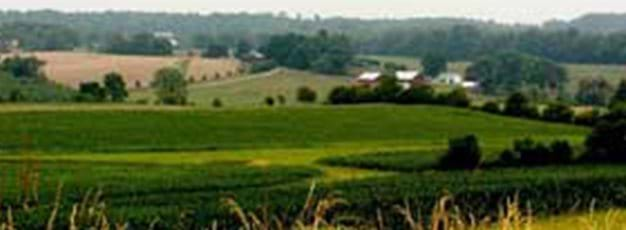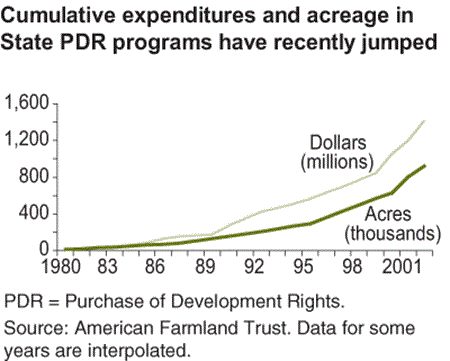Rural Amenities: A Key Reason for Farmland Protection

While conversions of farmland to urban uses represent less than 0.1 percent of U.S. farmland per year, local farmland losses continue to cause concern and motivate growing public support for farmland protection. The Federal Government, all 50 States, many local jurisdictions, and over 1,200 land trusts and nonprofit conservation programs seek to maintain more land in farming uses than would otherwise be the case.
Measures used to protect farmland include zoning, preferential tax assessments, agricultural districts, right-to-farm laws, and purchase of development rights (PDR) programs. Currently, 19 States and 41 local jurisdictions operate PDR programs, which pay farmers to give up rights to develop their land. To date, State PDR programs have spent nearly $1.4 billion to protect 922,000 acres of farmland, while local PDR programs have spent $604 million to protect an additional 214,000 acres. At the Federal level, the 2002 farm bill authorized more than a tenfold increase in funding for the Federal Farm and Ranch Lands Protection Program from about $53 million spent during 1996-2001 to $597 million authorized for 2002-07. Through 2001, the Federal program had helped protect about 108,000 acres.
ERS analysts found various objectives mentioned in the authorizing legislation for State farmland protection programs, including protecting 'rural amenities,' local food supplies, water and air quality, and natural resource jobs, and reducing urban sprawl (36, 30, 29, 23, and 18 States, respectively). Rural amenities include open space, scenic views, rural agrarian character, and wildlife habitat that are enjoyed through viewing or recreation, depending upon the degree of access permitted. The presence of 'natural amenities,' such as varied topography, trees, bodies of water, and temperate climate in rural areas, may contribute to rural amenities. (Another finding in this issue—The Roots of Rural Population Loss—discusses natural amenities in a different context.) States and counties use several criteria to select land parcels for preservation in PDR programs. Of 13 programs examined by ERS, 10 assigned the most weight to lands with high-quality soils often used for crop farming. Nine PDR programs assigned the second-most weight to larger farms or blocks of farms, a strategy that favors clustering of farming-related amenities. Five programs favored a 'least cost' strategy, which can result in a more scattered pattern of protected land, or in protection of lands distant from urban centers. These differences in strategies reflect different objectives but also highlight the difficult decisions faced by policymakers and program managers.
ERS also found that State farmland protection measures are generally tied to State-specific circumstances, such as the amount of land remaining in agriculture, types of agricultural industries, and lands in parks, forests, and other protected areas. While parks and protected lands provide many rural and open-space amenities, State legislators and the people they represent believe farmland, too, provides unique and valuable attributes worth protecting.
Farmland Protection: The Role of Public Preferences for Rural Amenities, by Daniel Hellerstein, Cynthia Nickerson, Joseph Cooper, Peter Feather, Dwight Gadsby, Daniel Mullarkey, Abebayehu Tegene, and Charles Barnard, USDA, Economic Research Service, April 2005
Land Use, Land Value & Tenure, by Scott Callahan, USDA, Economic Research Service, September 2023


